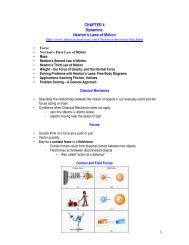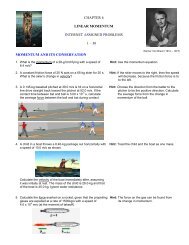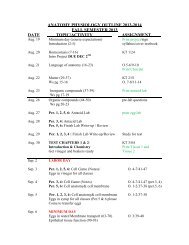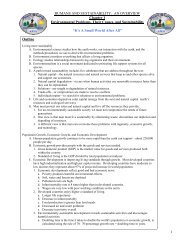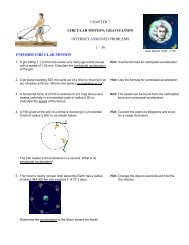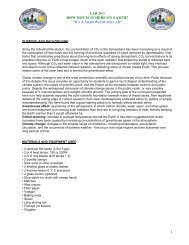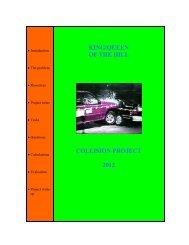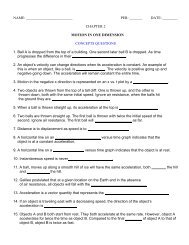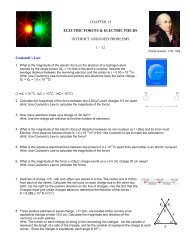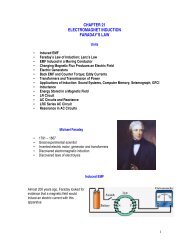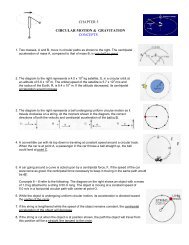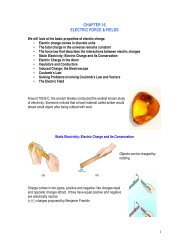CIRCULAR MOTION - GRAVITATION - Physics-matters.net
CIRCULAR MOTION - GRAVITATION - Physics-matters.net
CIRCULAR MOTION - GRAVITATION - Physics-matters.net
Create successful ePaper yourself
Turn your PDF publications into a flip-book with our unique Google optimized e-Paper software.
CHAPTER 5<br />
<strong>CIRCULAR</strong> <strong>MOTION</strong> - <strong>GRAVITATION</strong><br />
http://www.physicsclassroom.com/Class/circles/circtoc.html<br />
Units<br />
• Kinematics of Uniform Circular Motion<br />
• Dynamics of Uniform Circular Motion<br />
• Highway Curves, Banked and Unbanked<br />
• Nonuniform Circular Motion<br />
• Centrifugation<br />
• Newton’s Law of Universal Gravitation<br />
• Gravity Near the Earth’s Surface; Geophysical Applications<br />
• Satellites and “Weightlessness”<br />
• Kepler’s Laws and Newton’s Synthesis<br />
Circular Motion<br />
An object moving in a circle must have a force acting on it;<br />
otherwise it would move in a straight line.<br />
The direction of the force is towards the center of the circle.<br />
Kinematics of Uniform Circular Motion<br />
Looking at the change in velocity in the limit that the time interval becomes infinitesimally small, we<br />
see that 2<br />
v<br />
aR<br />
=<br />
r<br />
1
This acceleration is called the centripetal, or radial, acceleration, and it<br />
points towards the center of the circle.<br />
Forces in Accelerating Reference Frames<br />
• Distinguish real forces from fictitious forces<br />
• “Centrifugal” force is a fictitious force<br />
• Real forces always represent interactions between objects<br />
Example 1: A 150-g ball at the end of a string is revolving<br />
uniformly in a horizontal circle of radius 0.600 m. The ball makes<br />
2.00 revolutions in a second. What is its centripetal acceleration<br />
2π<br />
r 2(3.14)(0.600 m)<br />
v= = = 7.54 m/<br />
s<br />
T (0.500 s)<br />
a<br />
R<br />
2 2<br />
= v (7.54 m/ s)<br />
94.7 m/<br />
r<br />
= (0.600 m)<br />
= s<br />
2<br />
Example 2: The Moon’s orbit about the Earth has a radius of 384,000 km and a period T of 27.3<br />
days. Determine the acceleration of the Moon toward the Earth.<br />
2 2 2 2 8<br />
v (2 r) 4 r 4 (3.84x10 m)<br />
aR<br />
= = π = π = π = 2.72x10 − m/<br />
s<br />
2 2 6 2<br />
r T r T (2.36x10 s)<br />
2<br />
In terms of g ( 9.80 m/<br />
s ):<br />
−3 2⎛<br />
g ⎞<br />
−4<br />
a= 2.72x10 m/ s ⎜<br />
2.78x10<br />
2 ⎟=<br />
g<br />
⎝9.80 m/<br />
s ⎠<br />
3 2<br />
Dynamics of Uniform Circular Motion<br />
There is no centrifugal force pointing<br />
outward; what happens is that the<br />
natural tendency of the object to<br />
move in a straight line must be<br />
overcome.<br />
If the centripetal force vanishes, the<br />
object flies off tangent to the circle.<br />
2
This force may be provided by the tension in a string, the normal<br />
force, or friction, among others.<br />
Example 3: Estimate the force a person exerts on a string attached to a 0.150-kg ball to make the<br />
ball revolve in a horizontal circle of radius 0.600 m. The ball makes 2.00 revolutions per second (T<br />
= 0.50s)<br />
F = ma a = v 2 / r v=<br />
2 π r/<br />
T<br />
R<br />
v= 2 π (0.600 m) /(0.500 s) = 7.54 m/<br />
s<br />
2 2<br />
v<br />
(7.54 m/ s)<br />
FT<br />
= m = (0.150 kg) ≈14N<br />
r<br />
(0.600 m)<br />
Vertical Circle<br />
• Look at the forces at the top of the circle<br />
• The minimum speed at the top of the circle can be found<br />
vtop<br />
= gR<br />
Example 4: A 0.150-kg ball on the end of a 1.1-m-long cord is swung<br />
in a vertical circle. (a) Determine the minimum speed the ball must<br />
have at the top of its arc so that the ball continues moving in a circle.<br />
v<br />
= gr<br />
v m s m<br />
2<br />
= (9.80 / )(1.10 ) = 3.28 m/<br />
s<br />
3
(b) Calculate the tension in the cord at the bottom of the arc, assuming the ball is moving at twice<br />
the speed of part (a).<br />
2<br />
v<br />
FT<br />
= m + mg<br />
r<br />
2<br />
(6.56 m/ s)<br />
2<br />
FT<br />
= (0.150 kg) + (0.150 kg)(9.80 m/ s ) = 7.34N<br />
(1.10 m)<br />
Highway Curves, Banked and Unbanked<br />
When a car goes around a curve, there must be a <strong>net</strong> force towards the center of the circle of<br />
which the curve is an arc. If the road is flat, that force is supplied by friction.<br />
If the frictional force is insufficient, the car will tend to move<br />
more nearly in a straight line, as the skid marks show.<br />
As long as the tires do not slip, the friction is static. If the<br />
tires do start to slip, the friction is ki<strong>net</strong>ic, which is bad in<br />
two ways:<br />
1. The ki<strong>net</strong>ic frictional force is smaller than the<br />
static.<br />
2. The static frictional force can point towards the<br />
center of the circle, but the ki<strong>net</strong>ic frictional force<br />
opposes the direction of motion, making it very<br />
difficult to regain control of the car and continue<br />
around the curve.<br />
Banking the curve can help keep cars from skidding. In fact, for<br />
every banked curve, there is one speed where the entire<br />
centripetal force is supplied by the horizontal component of the<br />
normal force, and no friction is required. This occurs when:<br />
4
Example 5: A 1000-kg car rounds a curve on a flat road of radius 50<br />
m at a speed of 14 m/s. Will the car follow the curve, or will it skid<br />
(a) Assume the pavement is dry and the coefficient of static friction is<br />
μ = 0.60 .<br />
s<br />
FN<br />
on the car is equal to the weight mg since the road is flat.<br />
2<br />
FN<br />
= mg = (1000 kg)(9.8 m/ s ) = 9800N<br />
The <strong>net</strong> horizontal force required to keep the car moving in a circle<br />
around the curve is<br />
2 2<br />
v<br />
(14 m/ s)<br />
FR<br />
= maR<br />
= m = (1000 kg) = 3900N<br />
r<br />
(50 m)<br />
The maximum friction force attainable is<br />
F = μ F = (0.60)(9800 N) = 5900N<br />
fr S N<br />
Since the force of only 3900 N is needed the car can follow the<br />
curve.<br />
(B) If the pavement was icy and μ<br />
S<br />
= 0.25 then the maximum static friction force possible is<br />
F = μ F = (0.25)(9800 N) = 2500N<br />
fr S N<br />
The car will skid because the ground cannot exert sufficient force (3900N) to keep it moving in a<br />
curve.<br />
Example 6: What is the banking angle needed for an expressway<br />
off-ramp with a curve radius of 50 m at a design speed of 50 km/h<br />
2<br />
v<br />
tanθ =<br />
rg<br />
2<br />
(14 / )<br />
tan θ = m s<br />
= 0.40 = 21.8<br />
2<br />
(50 m)(9.80 m/ s )<br />
o<br />
Nonuniform Circular Motion<br />
If an object is moving in a circular path but at varying speeds, it<br />
must have a tangential component to its acceleration as well as<br />
the radial one. This concept can be used for an object moving<br />
along any curved path, as a small segment of the path will be<br />
approximately circular.<br />
5
Centrifugation<br />
A centrifuge works by spinning very fast. This means there must<br />
be a very large centripetal force. The object at A would go in a<br />
straight line but for this force; as it is, it winds up at B.<br />
Newton’s Law of Universal Gravitation<br />
If the force of gravity is being exerted on objects on Earth, what<br />
is the origin of that force<br />
Newton’s realization was that the force must come from the<br />
Earth.<br />
He further realized that this force must be what keeps the Moon<br />
in its orbit.<br />
• Every particle in the Universe attracts every other<br />
particle with a force that is directly proportional to the<br />
product of the masses and inversely proportional to the<br />
square of the distance between them.<br />
mm<br />
1 2<br />
F = G r<br />
2<br />
The gravitational force on you is one-half of a Third Law pair: the Earth exerts a downward force on<br />
you, and you exert an upward force on the Earth.<br />
When there is such a disparity in masses, the reaction force is<br />
undetectable, but for bodies more equal in mass it can be<br />
significant.<br />
Therefore, the gravitational force must be proportional to both<br />
masses.<br />
By observing pla<strong>net</strong>ary orbits, Newton also concluded that the<br />
gravitational force must decrease as the inverse of the square<br />
of the distance between the masses.<br />
6
Gravitation Constant<br />
• Determined experimentally<br />
• Henry Cavendish<br />
– 1798<br />
• The light beam and mirror serve to amplify the motion<br />
Example 6: A 50-kg person and a 75-kg person are sitting next to each other (0.5m) in the<br />
classroom. Estimate the magnitude of the gravitational force each exerts on the other.<br />
−11 2<br />
F G mm<br />
1 2<br />
(6.67x10 N⋅<br />
m )(50 kg)(75 kg)<br />
−6<br />
= = r 2 2<br />
= 110 x N<br />
(0.5 m )<br />
Example 7: Three 0.300-kg pool balls are placed on a table at the<br />
corners of a right triangle. Find the <strong>net</strong> gravitational force on the<br />
cue ball.<br />
Find the <strong>net</strong> gravitational force on the cue ball.<br />
21<br />
F on m 2 on m 1<br />
mm<br />
2 1<br />
F21 = G r<br />
2<br />
21<br />
−11 0.3 kg)(0.3 kg)<br />
−11<br />
= (6.67x10 ) = 3.75x10<br />
N<br />
2<br />
(0.4 m)<br />
F 31<br />
by m 3 on m 1<br />
mm<br />
3 1<br />
−11 (0.3 kg)(0.3 kg)<br />
−11<br />
F31 = G = (6.67x10 ) = 6.67x10<br />
N<br />
2 2<br />
r<br />
(0.3 m)<br />
31<br />
F = F + F = (6.67) + (3.75) X10 N = 7.65x10<br />
N<br />
2 2 2 2 −11 −11<br />
X Y<br />
7
Example 8: An astronaut standing on the surface of Ceres, the largest asteroid drops a rock from<br />
a height of 10.0 m. It takes 8.06 s to hit the ground.<br />
(a) Calculate the acceleration of gravity on Ceres:<br />
1<br />
Δ x = vt<br />
o<br />
+ at<br />
2<br />
2<br />
1<br />
− 10.0m= 0 + [ − g (8.06 s) ] = 0.308 m/<br />
s<br />
2 C<br />
2 2<br />
(b) Find the mass of Ceres, given that the radius of Ceres is 510 km.<br />
=<br />
M m<br />
C<br />
mgC<br />
G R<br />
2<br />
C<br />
g R<br />
= = g<br />
G<br />
2<br />
C C<br />
21<br />
M<br />
C<br />
1.20x10<br />
k<br />
Gravity near the Earth’s Surface; Geophysical Applications<br />
Now we can relate the gravitational constant to the local acceleration of gravity. We know that, on<br />
the surface of the Earth:<br />
Solving for g gives:<br />
Now, knowing g and the radius of the Earth, the mass of the Earth can be calculated:<br />
Kg<br />
Gravity Near the Earth’s Surface; Geophysical Applications<br />
The acceleration due to gravity varies over the Earth’s surface<br />
due to altitude, local geology, and the shape of the Earth, which<br />
is not quite spherical.<br />
Example 9: Estimate the effective value of g on top of Mt.<br />
Everest, 8850 m above sea level.<br />
−11 2 2 24<br />
mE<br />
(6.67x10 N⋅<br />
m / kg )(5.98x10 kg)<br />
g = G = = 9.77 m/<br />
s<br />
2 6 2<br />
r<br />
(6.389x10 )<br />
r = 6380 km + 8.9 km = 6389 km<br />
2<br />
8
Satellites and “Weightlessness”<br />
Satellites are routinely put into orbit around the Earth. The<br />
tangential speed must be high enough so that the satellite<br />
does not return to Earth, but not so high that it escapes<br />
Earth’s gravity altogether.<br />
The satellite is kept in orbit by its speed – it is continually falling, but<br />
the Earth curves from underneath it.<br />
Objects in orbit are said to experience weightlessness. They do have<br />
a gravitational force acting on them, though!<br />
The satellite and all its contents are in free fall, so there is no normal<br />
force. This is what leads to the experience of weightlessness.<br />
r<br />
Example 10: A geosynchronous satellite is one that stays above<br />
the same point on the Earth, which is possible only if it is above<br />
a point on the equator. Determine the height above the Earth’s<br />
surface such a satellite must orbit.<br />
2<br />
3 GmET<br />
r =<br />
2<br />
4π<br />
T = 1 day = (24h)(3600s/h)=86,400s<br />
Gm T (6.67x10 )(5.98x10 )(86,400)<br />
4π<br />
4π<br />
2 −11 24 2<br />
3 E<br />
22 3<br />
= = = 7.54x10<br />
m<br />
2 2<br />
7<br />
r = 4.23x10<br />
m or 42,300km − 6380km = 36,000km<br />
The satellites speed has to be<br />
−11 24<br />
GmE<br />
(6.67x10 )(5.98x10 )<br />
v= = = 3070 m/<br />
s<br />
7<br />
r<br />
(4.23x10 )<br />
Escape Speed<br />
• The escape speed is the speed needed for an object to soar off into space and not return<br />
v<br />
esc<br />
=<br />
2GM<br />
E<br />
R<br />
E<br />
9
• For the earth, v esc is about 11.2 km/s<br />
• Note, v is independent of the mass of the object<br />
Various Escape Speeds<br />
• The escape speeds for various members of the solar<br />
system<br />
• Escape speed is one factor that determines a<br />
pla<strong>net</strong>’s atmosphere<br />
Johannes Kepler (1571 – 1630)<br />
was a German mathematician, astronomer and astrologer,<br />
and a key figure in the 17 th century astronomical revolution.<br />
He is best known for his laws of pla<strong>net</strong>ary motion.<br />
Kepler’s Laws and Newton's Synthesis<br />
Kepler’s laws describe pla<strong>net</strong>ary motion.<br />
1. The orbit of each pla<strong>net</strong> is an ellipse, with<br />
the Sun at one focus.<br />
10
2. An imaginary line drawn from each pla<strong>net</strong> to the Sun<br />
sweeps out equal areas in equal times.<br />
3. The square of the orbital period of any pla<strong>net</strong> is<br />
proportional to cube of the average distance from the Sun<br />
to the pla<strong>net</strong>.<br />
2 3<br />
T = Kr<br />
– For orbit around the Sun, K = K S = 2.97x10 -19 s 2 /m 3<br />
– K is independent of the mass of the pla<strong>net</strong><br />
Example 11: Mar’s period was noted by Kepler to be about 687 days (Earth days), which is<br />
(687d/365d) = 1.88yr. Determine the distance of Mars from the Sun using the Earth as a reference.<br />
11<br />
rES<br />
= 1.50x10<br />
m<br />
2 2<br />
r ⎛ 3 3<br />
MS<br />
T ⎞<br />
M<br />
⎛1.88yr⎞<br />
= ⎜ ⎟ = ⎜ ⎟ = 1.52<br />
rES<br />
⎝TE<br />
⎠ ⎝ 1yr<br />
⎠<br />
11<br />
So Mars is 1.52 times the Earth’s distance from the sun or 2.28x10<br />
m .<br />
11
CHAPTER 5<br />
<strong>CIRCULAR</strong> <strong>MOTION</strong> & <strong>GRAVITATION</strong><br />
CONCEPTS<br />
1. Two masses, A and B, move in circular paths as shown to the right. The<br />
centripetal acceleration of mass A, compared to that of mass B, is one-half<br />
as great.<br />
2. The diagram to the right represents a 4.0 x 10 2 kg satellite, S, in a circular orbit<br />
at an altitude of 5.6 x 10 6 m. The orbital speed of the satellite is 5.7 x 10 3 m/s<br />
and the radius of the Earth, R, is 6.4 x 10 6 m. If the altitude decreased, its<br />
centripetal acceleration would increase.<br />
3. The diagram to the right represents a ball undergoing uniform circular motion as it<br />
travels clockwise on a string. At the moment shown in the diagram, the correct<br />
directions of both the velocity and centripetal acceleration of the ball is B.<br />
4. A convertible car with its top down is traveling at constant speed around a<br />
circular track. When the car is at point A, a passenger in the car throws a ball<br />
straight up, the ball could land at point C.<br />
5. A car going around a curve is acted upon by a centripetal force, F, if the speed of the car<br />
were twice as great, the centripetal force necessary to keep it moving in the same path would<br />
be 4F.<br />
Concepts 6 – 8 refer to the following: The diagram on the right shows an<br />
object with a mass of 1.0 kg attached to a string 0.50 m long. The object is<br />
moving at a constant speed of 5.0 m/s in a horizontal circular path with<br />
center at point O.<br />
12
6. While the object is undergoing uniform circular motion, its acceleration is directed toward<br />
the center of the circle.<br />
7. If the string is lengthened while the speed of the object remains constant, the centripetal<br />
acceleration of the object will decrease.<br />
8. If the string is cut when the object is at position shown, the path the object will travel from<br />
this position will be a straight line tangent to the circle.<br />
Concepts 9 – 13 refer to the following: The diagram to the right represents a ball of<br />
mass M attached to a string. The ball moves at a constant speed around a flat<br />
horizontal circle of radius R.<br />
9. The centripetal acceleration of the ball is constant in magnitude, but changing in<br />
direction.<br />
10. If the velocity of the ball is doubled, the centripetal accelration is quadrupled.<br />
11. If the string is shortened while the speed of the ball remains the same, the centripetal<br />
acceleration will increase.<br />
12. When the ball is in the position shown, the directioin of the centripetal force is toward point D.<br />
13. If the mass of the ball is decreased, the centripetal force required to keep it moving in the<br />
same circle at the same speed decreases.<br />
Concepts 14 & 15 refers to the following: A 60-kg adult and a 30-kg child are passengers<br />
on a rotor ride. When the rotating hollow cylinder reaches a certain constant speed, v, the<br />
floor moves downward. Both passenger stay “pinned” against the wall of the rotor, as<br />
shown to the right.<br />
14. The magnitude of the frictional force between the adult and the wall<br />
of the spinning rotor is F. The magnitude of the frictional force<br />
between the child and the mass of the spinning rotor is 1/2 F.<br />
15. Compared to the magnitude of the acceleration of the adult, the<br />
magnitude of the acceleration of the child is the same.<br />
16. The best description of the force keeping the ball in the circular path is that it is<br />
perpendicular to the circle and directed toward the center of the circle.<br />
17. The shape of the path of the Earth about the Sun is an ellipse<br />
with the Sun at one focus.<br />
18. The shapes of the paths of the pla<strong>net</strong>s about the Sun are all<br />
ellipses with the Sun at one focus.<br />
13
19. The increase in a pla<strong>net</strong>’s speed as it approaches the Sun is described by<br />
Kepler’s Second Law. The best explanation for this empirical law is that<br />
the gravitational potential energy lost as the pla<strong>net</strong> nears the Sun becomes<br />
ki<strong>net</strong>ic energy.<br />
20. As the distance of a satellite from Earth’s surface increases, the time<br />
the satellite takes to make one revolution around the Earth increases.<br />
21. The condition required for a satellite to be in a geosynchronous orbit<br />
around the Earth’s is that the period of revolution of the satellite must<br />
be the same as the rotational period of the Earth.<br />
22. The banking angle in a turn on the Olympic bobsled track is not constant,<br />
But increases upward from the horizontal. Coming around a turn, the<br />
bobsled team will intentially “climb the wall”, then go lower coming out of<br />
the turn. They do this to take the turn at a faster speed.<br />
23. A roller coaster car is on a track that forms a circular loop in the vertical<br />
plane. If the car is to just maintain contact with the track at the top of the<br />
loop, the minimum value for its speed at that point is rg<br />
24. A pilot executes a vertical dive, and then follows a semi-circular arc<br />
until it is going straight up. Just as the plane is at its lowest point, the<br />
force on him is more than g, and pointing up.<br />
25. A spaceship is traveling to the moon. It is never beyond the pull of Earth’s<br />
gravity.<br />
14
26. An astronaut is inside a space capsule in orbit around the Earth. He is able to<br />
float inside the capsule because he and his capsule move with the same<br />
constant acceleration.<br />
27. A car goes around a curve of radius r at a constant speed v. The direction of the <strong>net</strong><br />
force on the car is toward the curve’s center.<br />
28. Two objects attract each other gravitationally. If the distance between their centers<br />
doubles, the gravitational force is cut a fourth.<br />
29. Two objects gravitationally attract each other. If the distance between their centers is<br />
cut in half, the gravitational force between them quadruples.<br />
30. The acceleration of gravity on the moon is one-sixth what it is on Earth. An object of mass<br />
72 kg is taken to the moon. Its mass there is 72 kg.<br />
15




